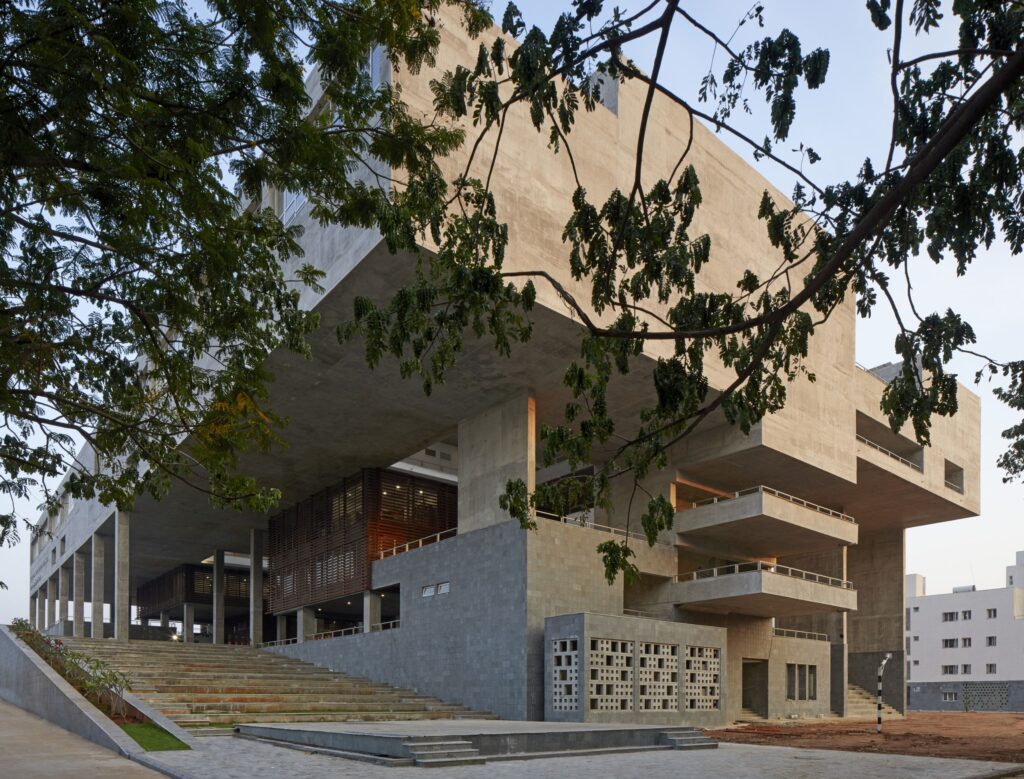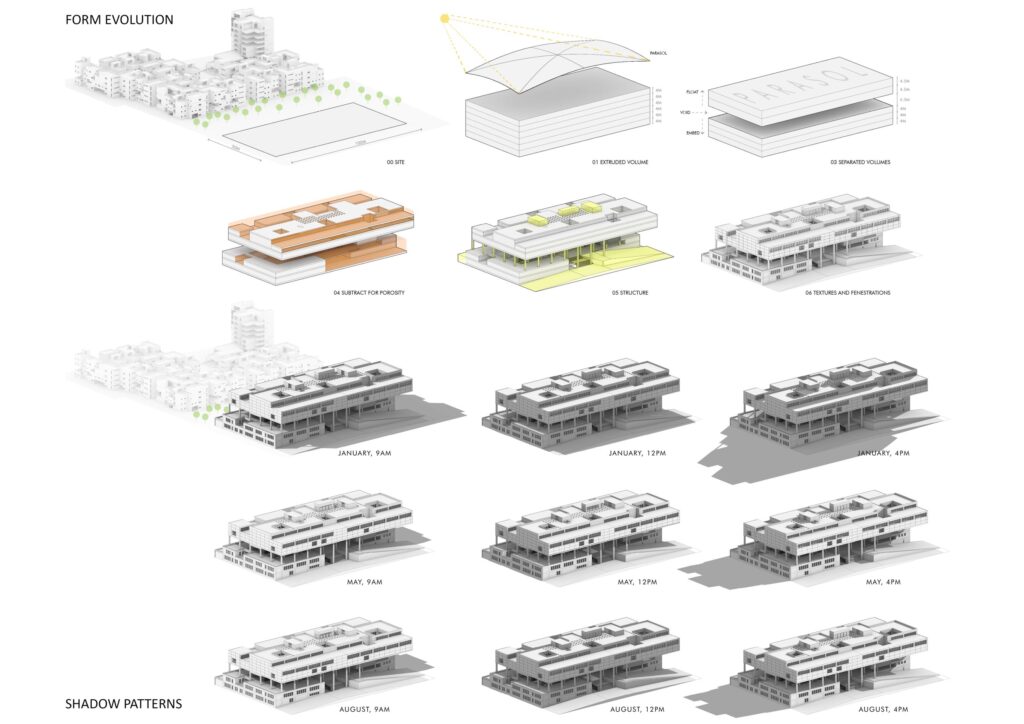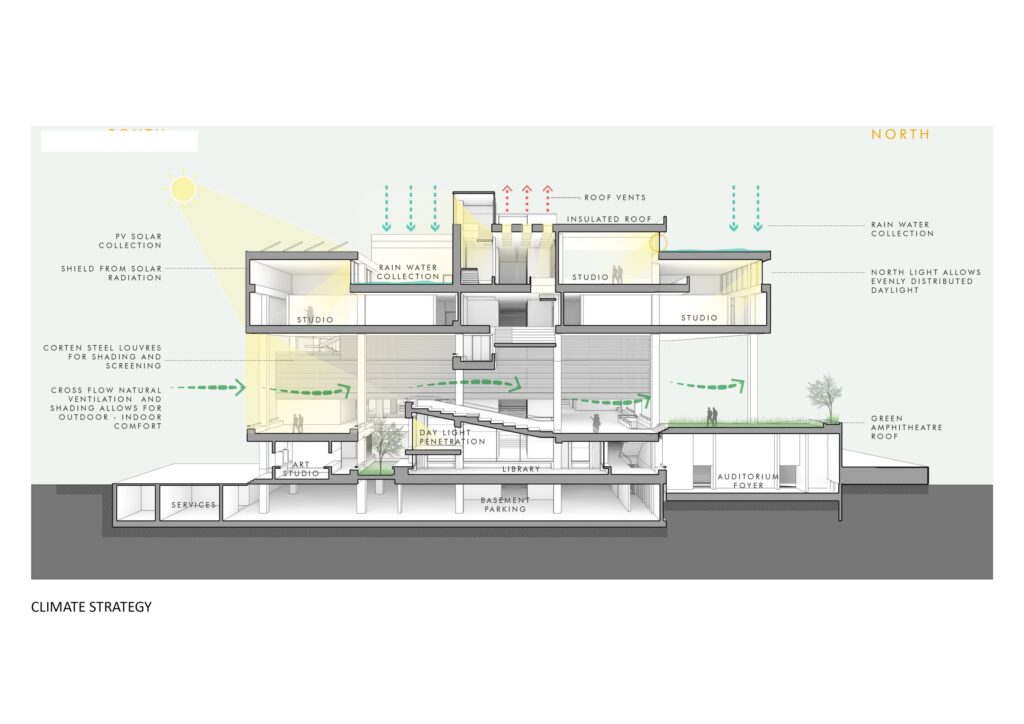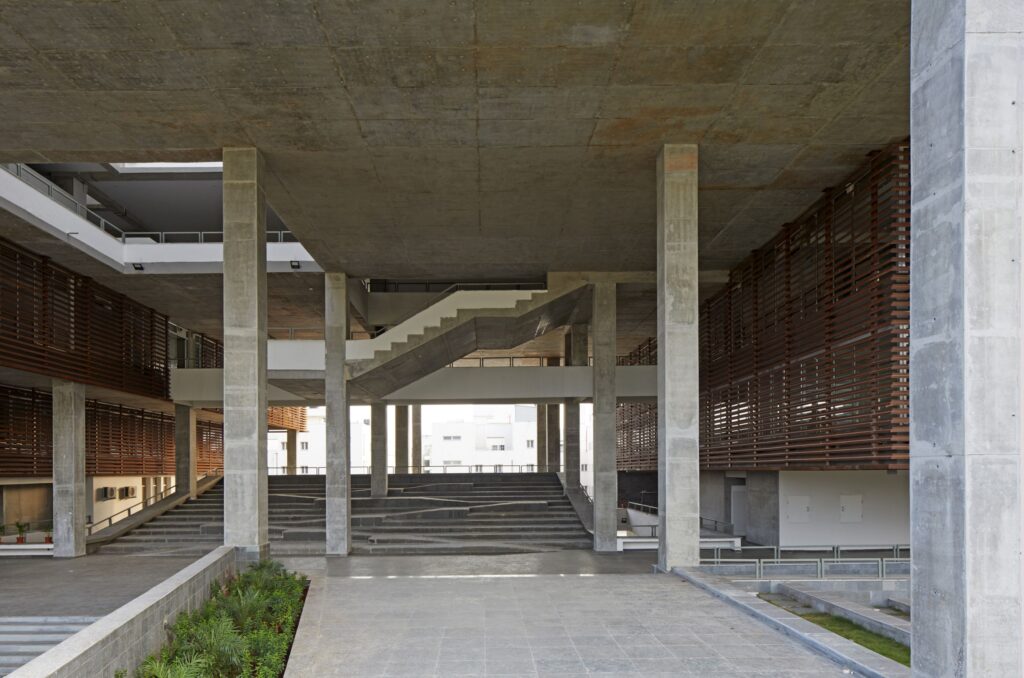
School of Planning And Architecture, Vijayawada, designed by Mobile Offices
Concept/Philosophy
The School of Planning and Architecture, Vijayawada, attempts to make the campus an institutional centre in the city of Vijayawada. The institutional building is a platform for academic debate, exchange and dissemination and becomes a deep gateway and an interface to the entire campus.
The building intends to create an interactive community learning environment nestled within its cultural context with a keen focus on environmental sensitivity. The Institute draws on the austere ideologies of Brutalism as a form of expression in a response to the extreme climate and positions it contextually in Vijayawada. The design demonstrates a scale akin to a public building on the outside and the inside explores the didactic nature of space by creating a humane scale apt for an engaged student community. The large volume is punctured by voids, creating a rhythmic play of light and shadows which allows the building to respire; thus yielding spatial patterns that perform as a scaling device. The design focuses on the diversity of individuals and the vastness of a community and creates interdependent programs that offer a multitude of interactive spaces that would be beneficial for a community experience.
Program and Organization
The relationships between three sections -The Parasol, Concourse and the Platform have been structured into a three-dimensional constellation that is informed by movement and varying levels of privacy of diverse programs.
PARASOL- The topmost section of the building houses the morning programs of the learning curriculum such as classrooms and studios. It also acts as a volumetric parasol roof for the lower floors creating a shaded environment below.
CONCOURSE – The middle section of the building is a ‘Stilted Platform’ that allows for student activity. This zone is a reminder of the traditional courtyard that anchors common public and community programs. It behaves as a concourse to the entire building as it filters and mediates the movement of people. Smaller courtyards work as three-dimensional light wells which offer visual connectivity through the layers above and below. This ‘Universal zone’ is occupied by faculty, students, administrators and visitors enabling non-programmed exchange.
PLATFORM-The bottommost section becomes a heavy base to a floating canopy. The base houses the afternoon programs of the learning curriculum such as workshops and laboratories and is cladded with local Tandur stone which increases the Time Lag for solar-heat gain. This solid platform is punctuated with voids that allow for hot air to dissipate.
Special features
MATERIALS OF CONSTRUCTION AND DETAILS

The materials are used in their raw form such as the fair-faced concrete walls on the periphery of the higher floors, local tandur stone in river wash finish for cladding the base of the building and polished river-washed tandur stone is used for flooring; corten steel is used as a louvred screen along with precast jail screens in certain areas. AAC Blocks with 70% fly ash content have been used. Energy consumption has been reduced through efficient lighting, HVAC, appropriate glass etc., and solar panels have been provided.
ENVIRONMENTAL SUSTAINABILITY

The building demonstrates responsive environmental architectural concerns through passive design strategies for the extremely hot and humid climate of Vijayawada.
Climatically the building harnesses the prevalent winds of the Krishna river basin to create cross ventilation and provide human comfort by convection in this hot and humid region. The courtyards funnel winds through the building and enable cross-ventilation, thus regulating the diurnal temperatures. The multiple voids render the building block porous, allowing the hot air to get extracted from the building, the north light windows bring in natural light in the studio spaces, and the parasol shades the informal spaces below, reducing energy usage for a building thus enabling it to be a model of passive energy design of building in harsh climates. The use of rainwater harvesting on terraces, solar energy for lighting, local materials, and treatment of waste all create a sustainable model of design for an institution of learning.
SOCIAL SUSTAINABILITY


The built environment is choreographed as a campus that is open, accessible and democratic in nature, breaking formal barriers between the street and the building envelope so as to bring education closer to the public realm thereby challenging contemporary hermetic organizational structures of educational campuses across the world.
The concourse is connected by multiple amphitheatres and stairs creating a platform for people, thereby making the architecture both interactive, inclusive and socially sustainable. The boundaries of the inner spaces are blurred to initiate conversations across the corridors, double-height spaces and through voids. The voids of the building form visual connective networks across departments of architecture and planning schools dissolving the floor-wise stratification of the building by spatially connecting programs with stairs in varied configurations across the section of the building.
Gallery
Drawings And Diagrams
Project Facts
Firm: MO-OF / Mobile Offices
Project Type: Master Planning, Institutional, Residential
Location: Vijayawada, Andhra Pradesh
Project Status: Completed 2012 -2018
Plot Area: 40000 sqm
Built-up Area: Institution Building: 26500 sqm
Student Housing: 16250 sqm; Faculty Housing: 4200 sqm;
Executing Agency: Central Public Works Department
Structural Consultants: Kelkar Design Private Limited
MEP consultants : Enova; Cutech; Epsilon
Quantity Surveyors: Dongre Associates
Team: Shivani Shedde, Shweta Sethi, Richa Raut, Pathik Joshi, Akshay Surana, P Vijay, Rushabh Chheda, Vatsal Upadhyaya, Chintan Shah, Vamsee Janardhan, Tanuj Jain, Nidhi Kacholia, Kunal Mokasdar

































3 Responses
I am happy to have been the JURY to select this project
We were fortunate to be a part of the competition process that had such a stellar jury. Such processes give hope to architects to participate in competitions.